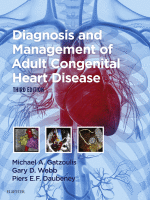Physical Address
304 North Cardinal St.
Dorchester Center, MA 02124

Introduction Since its first description in 1840 by Thurman, varying terminologies and classifications have been used to describe the sinus of Valsalva aneurysm (SV aneurysm). Because this lesion lies on a spectrum of other aortic root pathologies, it is important…

Etiology Aortic regurgitation (AR) rarely occurs as an isolated lesion, but is a common finding in patients with concomitant congenital heart lesions. It can result from primary disease of the aortic leaflets or secondary to pathology of the aortic root…

Patients with left ventricular outflow tract (LVOT) obstruction comprise a diverse group of neonates, infants, children, and young adults, accounting for up to 6% of adults with congenital heart disease (CHD). Congenital LVOT obstruction can occur at three levels; in…

Left ventricular outflow tract obstruction accounts for 5% to 10% of all congenital heart defects and may be due to stenosis at a valvular, subvalvular, or supravalvular level. The obstruction can be isolated or occur at multiple levels and is…

Acknowledgments I am deeply indebted for the mentorship, comments, and editorial guidance given to me by Drs. Gary Webb and Charles Bullaboy. Furthermore, I am indebted to my wife and children for affording me the time away from them to…

In 1966, Barlow and Bosman described a constellation of clinical findings consisting of nonejection systolic clicks and a late systolic murmur, T-wave abnormalities, and systolic aneurysmal billowing of the posterior mitral leaflet into the left atrium. Since then, in areas…

Introduction The main causes of congenital left atrial and ventricular inflow obstruction are pulmonary vein stenosis, cor triatriatum sinister (CTS), and mitral stenosis. Congenital pulmonary vein stenosis is usually a severe disease presenting in infancy with rare adult survival. This…

Definition and Morphology Definitions Atrioventricular septal defects (AVSDs) encompass a spectrum of cardiac anomalies. The hallmark feature is a five-leaflet atrioventricular (AV) valve with a common AV annulus that guards a common AV orifice, or separate left and right AV…

Definition and Morphology Ventricular septal defects (VSDs) are openings in the ventricular septum and occur both in isolation and in conjunction with other cardiac defects. The classification of VSDs is based on the location of the defect within the ventricular…

Definition and Morphology An atrial septal defect (ASD) is a direct communication between the cavities of the atrial chambers that permits shunting of blood. In the normal heart the true atrial septum is within the boundaries of the oval fossa;…